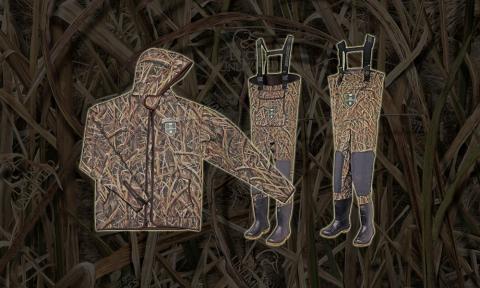Jeff Dennis | Originally published in GameKeepers: Farming for Wildlife Magazine. To subscribe, click here.
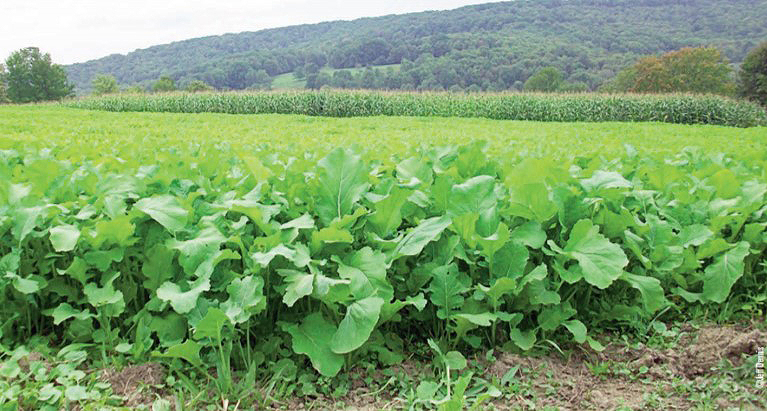
One of the biggest mistakes land managers make with their food plots is not fertilizing properly. Not all gamekeepers are exposed to the knowledge that your local agronomist possesses, and that makes them starved for education on the matter. Simply put, you don’t want to devote the time and effort to plan and plant a food plot and then withhold the ingredients that provide the best chance for success.
Working the ground and getting in some tractor time is universally accepted as time well spent for most of us and the purchase of fertilizer and seed kicks that “eagerness for outdoor recreation” into high-gear. If getting your food plots in tip-top shape is more exciting than the day you actually climb in a deer stand to hunt over them, then you might be a gamekeeper.
The proper balance and the correct amount of fertilizer can vary from plot to plot, but the intent should always be to produce the best crop possible. The better the plot’s forage production, the more resilient it will be into the hunting season. Multiple deer can make a real dent on a small plot during an overnight feed, but raccoons and even high concentrations of squirrels can tax a food plot. It is true that a properly fertilized plot draws more attention from critters than one that is lacking the proper nutrient levels, but because it gives the plants what they need it produces more forage and rebounds from browsing much easier.

It’s important to understand that your fertilizer isn’t going to work well if you have acidic soil (or a low pH). The reason is; with a low pH the nutrients are “bound in the soil” and the plants cannot pull them out. It’s amazing the amount of soil nutrients, or for that matter your fertilizer, goes to waste at low pH levels.
pH is measured on what is called a logarithmic scale. The difference between 6.0 and 7.0 isn’t 1 it’s actually 10 – the level is multiplied by 10 every number it moves away from 7. “Neutral: is “7,” below is acidic and higher than 7 is alkali or “alkaline.” Most soils used for planting food plots across the whitetails’ range will be on the acidic side of 7.
The good thing is lime is cheap; usually $40 to $70 per ton delivered to your location, and will cure your acidic soil…at least for the time being. Eventually your pH will revert back to where it started. It depends upon the type of soil you have as to how long the fix will last. In sand it works very fast but doesn’t last as long as clay which is on the other end of the soil spectrum. In clay it takes longer to work but lasts much longer.
It is important that you put a priority on spreading lime first since lime will take weeks to months to do its job depending on your soil type and how much moisture you receive. If the soil’s pH is too acidic, then it doesn’t really matter what fertilizer is applied because it simply won’t work properly. Some may have heard of the old adage, “if you can’t afford both lime and fertilizer, then just go with the lime.” Not only does the lime make the nutrients in your fertilizer available to your plants, but the existing nutrients in the soil that were unavailable due to the low pH can now be taken up.
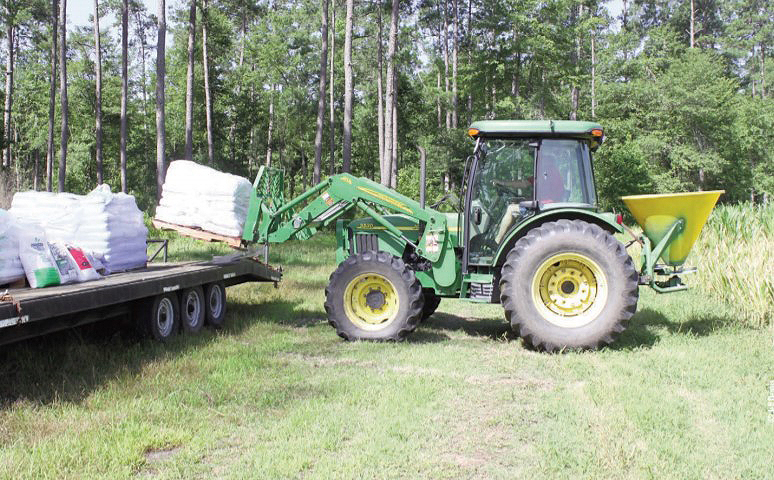
If you can't get a lime truck or spreader back to your plot then you've got some work to do. The other bad thing about lime, as opposed to the nitrogen, phosphorus or potassium (NPK) in your typical granular fertilizer which moisture will slowly carry through the soil for you, is lime is stationary in the soil (for the most part) so it needs to be worked into the soil. The calcium molecules need to be put where you want them to do their job. So get the lime on and worked in as soon as possible.
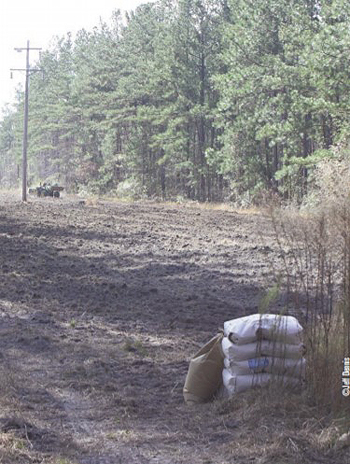
prepared for planting with seed and fertilizer ready
to go.
Don't worry, it doesn't mean you can't have a food plot in the meantime if you can’t add all the lime at once - add what you can for now and add more next year until you build it up to close to a neutral 7.0. Also consider, lime does come bagged, and just remember “where there’s a will there’s a way!”
We must also know the difference between pelletized lime and regular agricultural lime (also referred to as powdered lime, quarry lime or ground lime). Pelletized lime is easier to handle and apply. It can be applied with a broadcast type spreader where powdered lime requires a drop spreader or belt fed spreader. Pelletized lime works faster, but doesn’t last as long; it’s also more expensive ($50 to $100 per acre and powdered lime $20 to $60 per acre). Powdered ag-lime is less expensive and has a longer-lasting effect, usually two to three years or more.
Which type of lime you choose should depend upon several issues, like the size of your plot, your time horizon, whether you’re planting annuals ore perennials, whether you can get to the plot with the type of equipment you need, etc. A combination of both can be used when planting perennials – use the recommended amount of powdered lime and then 400-700 lbs of pelletized lime per acre (how much depends upon the actual pH). The pelletized lime gives a fast bump for the newly germinating perennials and the regular powdered lime will give some longevity to the plot. Be careful not to oversupply the lime; however, it may result in harm to plant life.
Timmy Benton of “Benton’s Feed &Seed” sells the all-important fertilizer varieties to a variety of customers ranging from plantations to small private landowners. “Getting the fertilizer equation right can also include knowing what was planted in that food plot in prior years and what if any fertilizer was used,” said Benton. “The process of planting food plots can get expensive, and I see the average man using smaller food plots less than one acre, but they aren’t following through with enough fertilizer. The danger there is that the crop will come up fine, but it may die as it runs out of fuel.”
An experiment anyone can do would be to add fertilizer to the weeds, thinned woods or a logging road near your food plot. If the deer and other wildlife pay more attention to the test areas, then it is a clear sign that your food plot planting isn’t all that it should be. Palatability or taste does matter to white-tailed deer and a food plot packed with deer is the ultimate compliment to the dedicated land manager.
Keeping in mind that trial and error will always be a component of learning over time what works best for individual gamekeepers. Some say that a food plot planted in peas should never actually produce peas. If peas are produced it might mean a few different things, including that your hunting pressure was too high, your neighbor had some plantings nearby that were tastier or that you simply did not fertilize enough to offer nutrients in the forage.
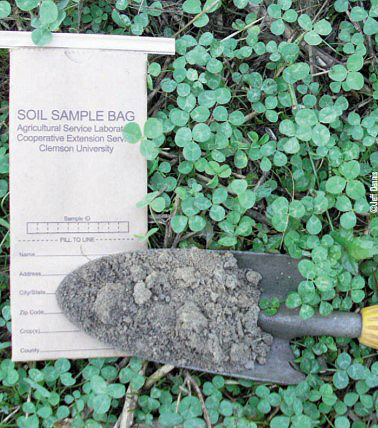
be done to every plot.
Hugh McLaurin of Elloree, S.C. is a big time farmer with 3,000-acres under cultivation at his “Cotton Lane Farms.” “As an avid hunter, I am planting food plots for deer and ducks and I know it will take fertilizer and rain for them to make,” said McLaurin. “I know that corn and sorghum need more nitrogen than legumes like peanuts and soybeans that fix their own nitrogen. So I say go with a custom fertilizer blend if you can find it. The middle number, or phosphorous, is the ingredient that we as farmers are high on. You need the outside two numbers the least, and nitrogen and potash leach out of the soil easily.”
“It takes 1.2-pounds of nitrogen to make a bushel of corn,” said McLaurin. “So the next step in figuring out the correct amount of fertilizer is to establish the size of your food plot. Measure the width and length of the plot (in feet) and multiply those numbers together then divide by 43,560 to determine your food plot acreage. If you use a rangefinder and measure in yards you do the same thing, but divide by 4,840. Remember that something like corn carries a big stalk so it will require more ingredients to make, which is why some choose to come back and top-dress their crop with nitrogen to give it a late kick.” This is also a great plan for brassicas.
“Another example of note is all the reports of deer coming into yards to eat the flowers,” said McLaurin. “Those are plants that have been fertilized and they are seeking that sustenance…the nutrients. I would think eating something without fertilizer in it would be akin to them eating something that tasted like paper. I have heard that fertilizing a fallow field can make a pretty attractive food plot. Since it’s all about the nutrients.”
“We’ll hunt over food plots, and adjust the plans when the acorns begin to drop,” said McLaurin. “But we remain committed to food plots so that we can offer the highest nutrition to our wildlife. You’ve got to put the money into the ground to maximize any crop, whether it’s producing peanuts for the mill or planting for wildlife.”

















